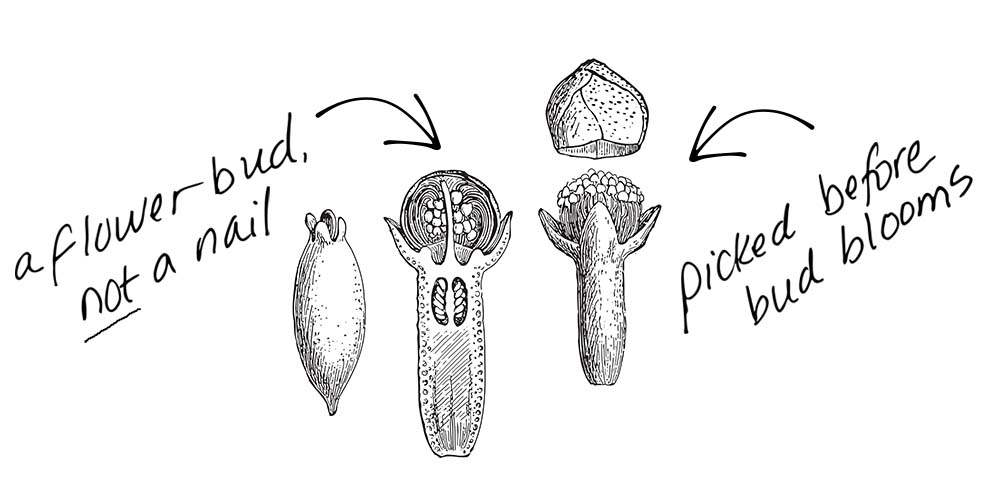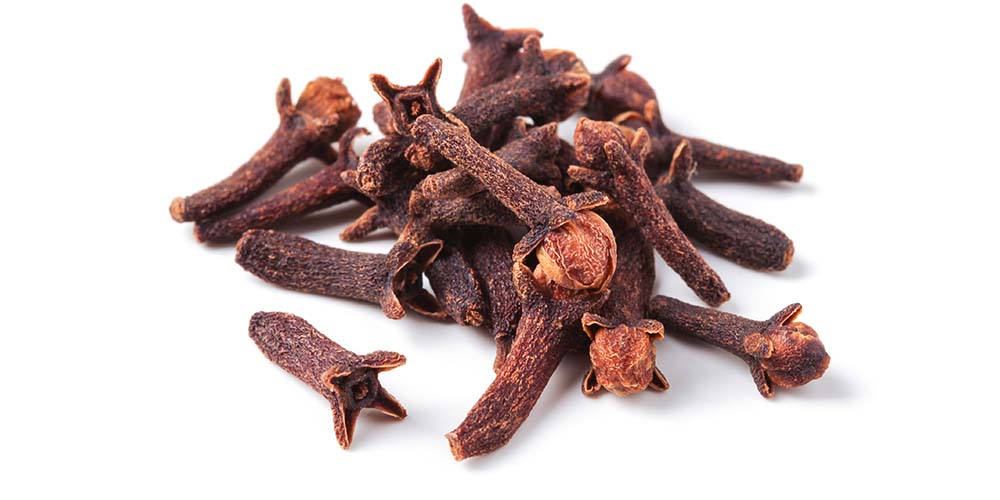featuring
CLOVES
SELECT BANNER PHOTOGRAPHY BY: KIMBERLY DENNISON
THE NAIL SPICE
You might not expect that cloves were once grown on secret islands, are (indirectly) a reason chilies exist in southern Asia, and that Venice had a monopoly over trading them. While cloves may often be relegated to the holiday season in some of the West, you’ll find them used in everyday cooking to grand banquets in many other parts of the world.
Admittedly, I had a bit of a love/hate relationship with cloves as a kid, particularly when eating biryani. I loved the taste, but the random bite of the whole spice often used in the dish could be overpowering (and tough on the teeth!). Ironically, I now enjoy cooking with the whole spice, to the slight disappointment of my husband who had the same experience growing up. (He tries his best to pick them out ahead of time, but there are always a few sneaky ones!)

Cloves have a warming yet intense flavor, so a little goes a long, long way. Commonly known as the "nail spice" in many languages due to their shape, cloves have the highest eugenol content of any spice. That makes their aromatically pungent flavor stronger than cinnamon and nutmeg, in that regard.

*This article is by food blogger and Selefina creator Rena Sak (A Girl and a Spoon). At Selefina, we believe that cooking should be about exploring and experimenting with new ingredients. We hope having our creators share what they've learned about a spice will inspire others to go on their own journey.
FRAGRANT FLOWERS
Cloves, from the Latin clavus, are unopened flower buds from the clove tree, botanically known as Syzgium aromaticum. It’s a tropical evergreen and can grow forty to fifty feet high. It usually begins to flower in the fifth year and can produce cloves for up to one hundred! Clove buds are typically picked by hand twice yearly, once they turn pink-red before flowering. They’re dried until they harden and turn that dark brown color we’re familiar with.
The Moluccas Islands in Indonesia, once known as the Spice Islands, were renowned for their exclusive cultivation of the indigenous clove (along with nutmeg and mace). Indonesia is still the largest producer of cloves, although most of it is used in the local cigarette (kretek) industry. Madagascar and Tanzania produce much of what is exported worldwide, with India, Sri Lanka, and Pakistan being some of the smaller producers.
CLOVES: A TREASURE TROVE
Before European colonialism, cloves were exclusive to the Moluccas. They were purportedly traded as far back as around 1500 BC, later becoming part of the Spice Trade. However, archaeological evidence shows their presence in the region goes back much further. Cloves had been enjoyed for culinary and non-culinary use in much of Asia and their perfumatory power was particularly valued.
During the Middle Ages, cloves became popularized in the West after reaching Rome around the first century AD. Initially, the Republic of Venice had a monopoly over the trade due to its powerful hold on the Western spice trade in general. At the time, cloves would have been traded via the Silk Road, but once the Ottoman Empire took control of that, Western Europe took to the oceans to find alternative options.
During the Age of Exploration, Portugal was the first to sail out to the Indian Ocean, aiming for control of maritime spice trading. They eventually discovered the secret location of the Spice Islands, marking the beginning of centuries-long turbulent times for the isles now considered some of the most important real estate in the world.
From the Portuguese to the Dutch and the British, control was taken, fought over, and exchanged - sometimes more than once by the same country. Cloves stood unique in their difficulty to be truly monopolized by a foreign power. Unlike the even more exclusive nutmeg, grown only on the Banda islands within the Moluccas, cloves grew more abundantly. Who knows - perhaps the tradition of planting a tree for every child played a role.
USING CLOVES
Cloves’ primary flavor compound, eugenol, gives it that warming eucalyptus-like scent and sweet taste on the tongue. It also has minty and woodsy notes. Whether using whole or ground cloves, remember that they are very intense, so taming the flavor with similarly warm spices can be helpful for balance.
Moving eastwards, cloves are featured in several spice blends, including the Middle Eastern seven spice (baharaat) and Chinese five spice. I’ve found cloves in rice dishes from West African jollof recipes to pilafs in Eastern Europe and Asia. You may even recognize them in masala chai drinks or common curries, like Butter Chicken. The Vietnamese pho also typically contains heavy notes of clove in the soup base.
TIPS TO GET THE MOST OUT OF CLOVES
- Whole cloves are great for longer cooking times or infusions; adding them early will tame the intensity and disperse some of those woody notes
- Ground cloves release flavor faster; they’re ideal for quicker meals, baking, and dusting
- Use fat or alcohol in your dish to distribute the flavor compounds; they won’t dissolve as well in water
GET CREATIVE
- Add a clove or two in addition to (or instead of) a bay leaf in stews or sauces. It’s fantastic in a rich tomato sauce! Alternatively, substitute clove for nutmeg, like in a Béchamel sauce.
- Infuse whole cloves into syrups, such as the cinnamon clove syrup in the Gimblett Gravels Cocktail, or infuse milk for a unique hot chocolate or various milk-based puddings.
- Pair with eugenol-containing fruits, such as bananas in banana bread, or plums or peaches in a compote or preserve.
Balance is key! To balance out the intense flavor of cloves, pair them with similar spices to create a more mellowed, yet complementary, flavor profile.
-
For more...
- Woody/Warming Notes: add any of the warm spices, e.g. nutmeg, cinnamon, allspice, etc.
- Spicy Notes: add black or Sichuan pepper; try ginger, which will also complement its woody notes and bring out more of the slight citrus flavor
- Overall balance: Use a combination of cloves, cinnamon, star anise, and cardamom to replicate the “four siblings” in the Malay Rempah Empat Beradik blend
AVAILABLE
On a personal note: Powerful they are, but a pleasure to the senses - in moderation. In testing cloves for this Primer, I particularly enjoyed pairing it with more citrus-forward spices like ginger, lemongrass, or lime. I also learned to appreciate a good quality clove; the pungency and aroma from a nice plump one compared to the shriveled old ones I had can’t be compared. It is so much more complex and dimensional that I truly am excited to use it more in everyday cooking. — Rena Sak
